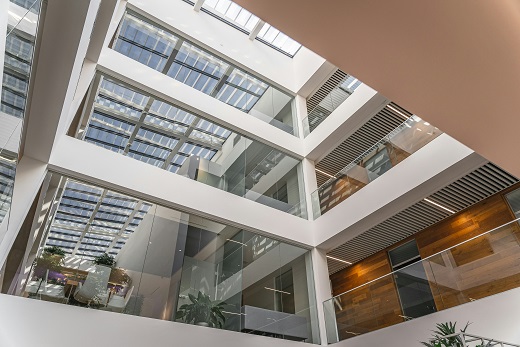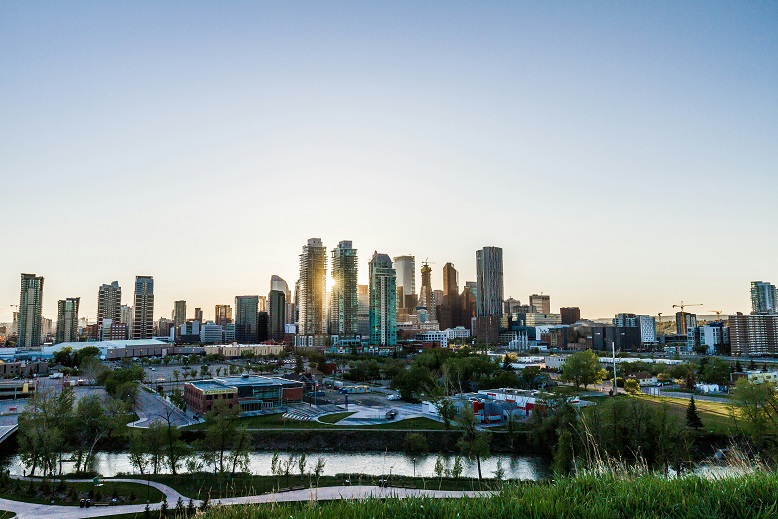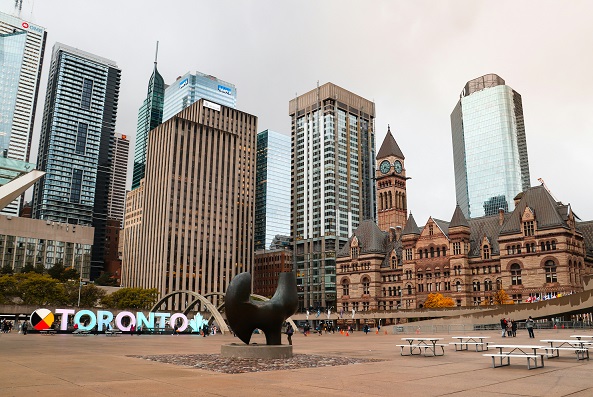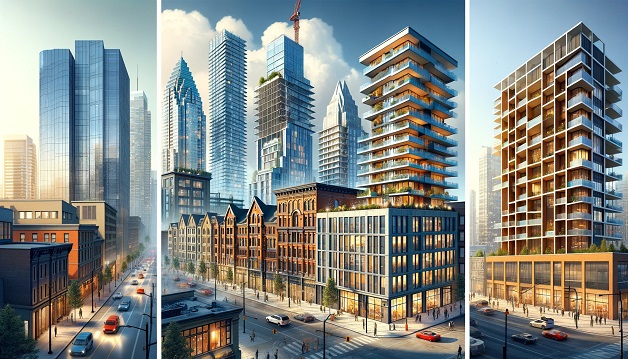Exploring the Shift from Office to Rental Spaces in Canada
In recent years, Canada has witnessed a remarkable trend: the transformation of office buildings into residential rental units. This shift, primarily driven by changing work patterns and the urgent need for more housing, is redefining urban landscapes across the country. Cities like Toronto, Vancouver, and Calgary are at the forefront of this movement, creatively repurposing underutilized office spaces to address their housing crises.

The trend gained momentum during the COVID-19 pandemic, which accelerated the adoption of remote work, leading to a significant reduction in the demand for office spaces. Concurrently, Canadian cities have been grappling with housing shortages, skyrocketing rents, and the need for more affordable living options. The conversion of office buildings to residential units presents a unique solution to these challenges, offering a way to rejuvenate empty or underused office spaces while contributing to the housing supply.
Economic and Social Drivers: Understanding the Forces Behind Office Building Conversions
Several economic and social factors are driving the conversion of office buildings into rental units in Canada:
- Office Vacancy Rates: The rise in remote work has led to higher office vacancy rates, particularly in downtown areas. This has prompted property owners to seek alternative uses for their buildings.
- Housing Shortage: Major Canadian cities are facing a significant shortage of affordable housing. Converting office spaces into residential units can help alleviate this issue by adding to the housing stock.
- Government Incentives: The Canadian government and various municipal bodies have introduced incentives to encourage the conversion of office buildings. These include tax breaks, simplified zoning and permit processes, and financial support.
- Sustainability: Repurposing existing structures is more environmentally sustainable than new construction. It reduces the carbon footprint associated with building materials and construction processes.
- Urban Revitalization: These conversions can revitalize city centers, bringing in more residents and supporting local businesses.
Case Studies Across Canada: Examining Successful Conversions in Major Cities

- Toronto: The city launched a program in 2021 to convert office spaces into residential units, which saw immediate interest with over a dozen applications and ten residential projects announced.
- Vancouver: Despite its acute need for housing, the city has been slower to adopt office-to-residential conversions. This is changing, with growing interest in repurposing office spaces to meet housing demands.
- Calgary: The city introduced an adaptive reuse incentive program, leading to successful conversions of office spaces for various uses, including residential and educational facilities.
Challenges and Opportunities: Navigating the Complexities of Transforming Office Spaces
Converting office buildings into residential units presents both challenges and opportunities:
- Structural Challenges: Office buildings are not designed for residential use, requiring significant alterations to make them livable.
- Financial Hurdles: High construction and borrowing costs can make conversions expensive.
- Zoning and Regulation: Navigating zoning laws and obtaining the necessary permits can be complex.
- Market Dynamics: Understanding the real estate market and tenant demands is crucial for successful conversions.
The Future of Urban Living: Envisioning How These Conversions Shape Canadian Cities
The conversion of office buildings into rental units is more than a trend; it’s a forward-thinking approach to urban development. It reflects a shift towards more sustainable, community-oriented urban spaces. These conversions can help create vibrant, mixed-use neighborhoods, reduce urban sprawl, and contribute to the creation of more inclusive cities. As this trend continues, it will play a crucial role in shaping the future of urban living in Canada.
Exploring the Shift from Office to Rental Spaces in Canada
The Emergence of a New Urban Landscape
In the heart of Canada’s bustling cities, a transformative trend is emerging: the conversion of office buildings into residential rental units. This shift, catalyzed by the pandemic-induced rise in remote work and an acute housing shortage, is reshaping urban centers like Toronto, Vancouver, and Calgary. These cities are now at the vanguard of a movement that is not only providing much-needed housing solutions but also reinvigorating underutilized urban spaces.
A Paradigm Shift in Workspace Utilization

The onset of the COVID-19 pandemic brought about a seismic shift in the traditional workspace model. With the rise of remote work, the demand for office spaces plummeted, leaving many buildings in prime urban locations underutilized or empty. This sudden change sparked a crucial question: how can these spaces be repurposed to address other pressing urban challenges?
Addressing the Housing Crisis
Canada’s major cities have long grappled with housing shortages, with skyrocketing rents and a dearth of affordable living options exacerbating the crisis. The conversion of office spaces into rental units presents an innovative solution, allowing for the efficient use of existing structures to increase the housing supply, particularly in densely populated urban areas.
A Win-Win Solution
This trend represents a win-win solution, addressing both the surplus of office space and the shortage of residential housing. It offers property owners an opportunity to repurpose their assets in a changing market, while city planners and residents benefit from a more diverse and dynamic urban fabric.
The Path Forward
As Canadian cities navigate this new landscape, they are setting a precedent for adaptive urban development. The conversion of office buildings to residential units is more than a trend; it’s a pivotal shift towards sustainable, community-centric urban living. This movement holds the potential to transform not only the physical skyline of Canadian cities but also the way we think about urban space and community living.

Economic and Social Drivers: Understanding the Forces Behind Office Building Conversions
A Shift in Work Culture: The Remote Work Revolution
The pandemic has irreversibly altered the work landscape, with remote work becoming a new norm for many. This shift has left a significant portion of office real estate underutilized, sparking a reevaluation of how this space can be repurposed. In cities like Toronto and Calgary, where office vacancy rates have soared, the transformation of these spaces into residential units is not just an opportunity; it’s a necessity.
Responding to the Housing Shortage
Canadian urban centers are experiencing a critical housing shortage, with demand far outstripping supply. This imbalance has led to inflated rental prices and a lack of affordable housing options. Converting office buildings into rental units offers a practical solution to this problem, utilizing existing structures to quickly augment the housing supply.
Government Initiatives and Incentives
Recognizing the potential of this trend, the Canadian government and local municipalities have introduced a range of incentives to facilitate these conversions. These include tax breaks, streamlined zoning and permit processes, and financial subsidies. Such initiatives aim to lower the barriers to conversion and make these projects more financially viable for developers and property owners.
Environmental Sustainability: A Green Approach
Adaptive reuse of office buildings is also a more environmentally sustainable approach compared to new construction. By repurposing existing structures, we significantly reduce the carbon footprint associated with building materials and construction processes, aligning with broader environmental goals and commitments.
Revitalizing Urban Centers
The conversion of office buildings into residential units offers a unique opportunity to revitalize city centers. These projects can breathe new life into underutilized areas, creating vibrant, mixed-use communities that combine living, working, and recreational spaces. This not only enhances the urban experience but also contributes to the economic vitality of city centers.
Case Studies Across Canada: Examining Successful Conversions in Major Cities
Toronto: Pioneering Urban Adaptation

Toronto, recognizing the potential of underutilized office spaces, launched an ambitious program in 2021 to encourage their conversion into residential units. This initiative quickly garnered interest, with over a dozen applications leading to the announcement of ten significant residential projects. These conversions are not just about adding housing stock; they’re about revitalizing downtown Toronto, making it a more liveable and vibrant space.
Vancouver: A Slow but Steady Shift
In Vancouver, where the housing crisis is particularly acute, the shift towards office-to-residential conversions has been slower. Yet, the city is now recognizing the immense potential of this approach. By repurposing office buildings, Vancouver can alleviate its housing shortage and revitalize its urban core, making it more attractive and sustainable.
Calgary: Leading with Incentives

Calgary stands out for its proactive stance in encouraging the adaptive reuse of office spaces. Through a successful incentive program, the city has facilitated the conversion of office buildings for various uses, including residential and educational facilities. These projects have not only addressed the excess office space but have also contributed to the diversification and enrichment of Calgary’s urban landscape.
Challenges and Opportunities: Navigating the Complexities of Transforming Office Spaces
Overcoming Structural Limitations

One of the primary challenges in converting office buildings into residential units is their structural design. Offices are typically designed with large, open floor plans, which may not easily translate into the segmented layout of residential units. Additionally, the installation of essential residential amenities, like kitchens and bathrooms, requires significant plumbing and electrical retrofitting.
Financial and Regulatory Hurdles
The financial aspect of these conversions can be daunting. High construction costs and borrowing rates pose a significant challenge, requiring careful financial planning and potentially support from government incentives. Moreover, navigating the complex web of zoning laws and obtaining the necessary permits can be a time-consuming and intricate process.
Balancing Market Needs and Expectations
Understanding and adapting to the real estate market is crucial. Developers must balance the demand for housing with the specific needs and expectations of potential residents. This includes considerations of location, unit size, amenities, and price points, ensuring that the converted spaces meet the market demand.
Leveraging Opportunities for Sustainable Development
Despite these challenges, the conversion of office buildings presents unique opportunities. It offers a path towards more sustainable urban development, utilizing existing structures to reduce environmental impact. Moreover, these projects can significantly contribute to the revitalization of city centers, creating vibrant, mixed-use spaces that enhance the urban living experience.

The Role of Innovation and Collaboration
Innovative design solutions and collaborative efforts between governments, developers, and communities are key to overcoming these challenges. By working together, stakeholders can find creative solutions that make the most of these conversion projects, turning challenges into opportunities for urban improvement.
The Future of Urban Living: Envisioning How These Conversions Shape Canadian Cities
Redefining Urban Spaces
The conversion of office buildings into residential units is more than a mere response to a temporary crisis; it is a forward-looking approach that redefines urban spaces. This trend is reshaping the very fabric of Canadian cities, turning monolithic business districts into vibrant, mixed-use communities. It signals a shift towards a more integrated urban living experience, where work, leisure, and living spaces coexist in closer harmony.
Sustainable Urban Development
These conversions play a pivotal role in sustainable urban development. By repurposing existing buildings, cities can reduce the environmental impact associated with new construction. This approach aligns with global sustainability goals, contributing to greener, more resilient urban environments.

Creating Inclusive Communities
One of the most significant impacts of these conversions is the creation of more inclusive urban communities. By increasing the availability of residential units, particularly in city centers, these projects have the potential to make urban living more accessible and affordable. This inclusivity is crucial for fostering diverse, vibrant communities.
Boosting Local Economies
The transformation of office spaces into residential units also has a positive impact on local economies. It attracts a more diverse population to city centers, boosting local businesses and services. This revitalization of urban cores can lead to more dynamic and economically stable cities.
Looking Ahead
As Canadian cities continue to adapt and grow, the conversion of office buildings into residential units will likely play a crucial role. This trend is not just about meeting immediate housing needs; it’s about envisioning and building the future of urban living – a future that is sustainable, inclusive, and vibrant.
